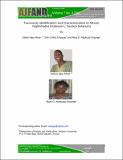| dc.description.abstract | African nightshades play an important role in meeting the nutritional needs of
rural households, and are reported as being particularly rich in protein, vitamin A,
iron and calcium. Nightshades are among three top priority African indigenous
vegetables identified for improvement and promotion through research. A major
constraint facing this objective is the scantiness of taxonomic and nomenclatural
knowledge on African nightshades resulting in extensive synonymy and
confusion. As a consequence, the toxic species are difficult to discriminate from
those with high nutritional value. It is also difficult to identify species with good
agronomic traits for genetic enhancement. This study was conducted to identify,
characterize, and delimit African nightshade species. Fifty accessions of
Solanum section Solanum from eastern, southern and western Africa were raised
in a greenhouse at the Botanical and Experimental Garden, Radboud University,
Nijmegen, the Netherlands. A descriptor list with 48 vegetative and reproductive
characters was developed and used to characterize flowering and fruiting plants.
Counting of chromosome was done on root squash preparations from one weekold seedlings, aided by digital enhancement of microscopic images. Nine species
were represented in the study material, including two diploids: Solanum
americanum, and Solanum chenopodioides; five tetraploids: Solanum
retroflexum, Solanum villosum, Solanum florulentum, Solanum grossidentatum
and Solanum tarderemotum; and two hexaploids: Solanum nigrum and Solanum
scabrum. Most of the section Solanum species were distinguishable and easily
identified. The exception was S. florulentum and S. tarderemotum which were
identified tentatively and assigned respective names, but are difficult to
differentiate and require further studies. The S. florulentum/tarderemotum group
has three distinguishable variants and further studies are needed to determine
the taxonomic status of each as a separate species, subspecies or
genotypic/phenotypic variants. Furthermore, S. retroflexum, S. villosum and S.
scabrum each had a high degree of within-species variation, and further studies
are recommended to determine whether the variations within each constitute
subspecies. | en_US |

